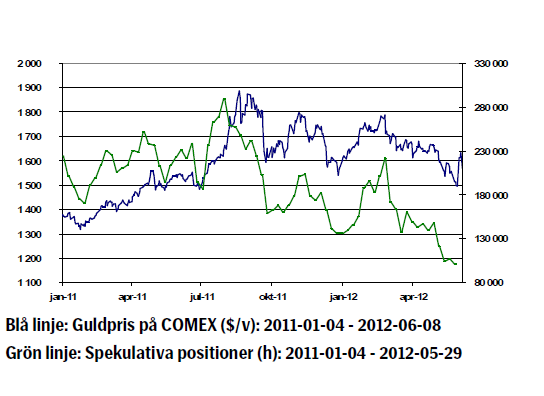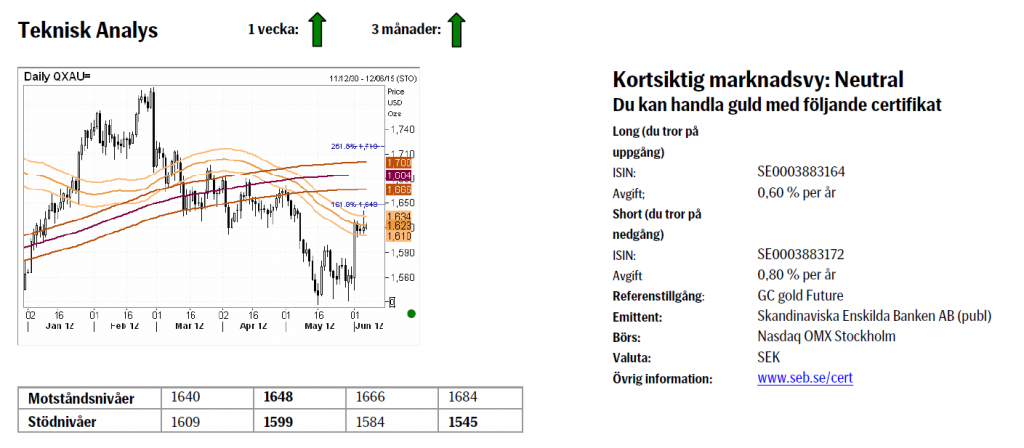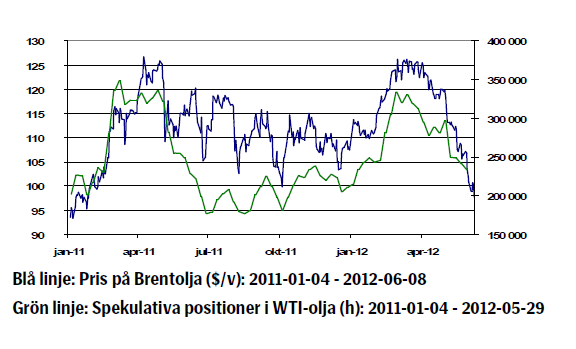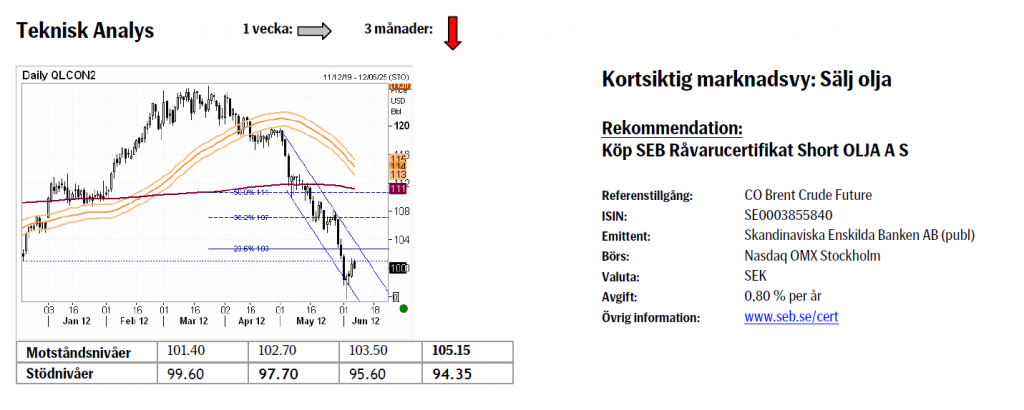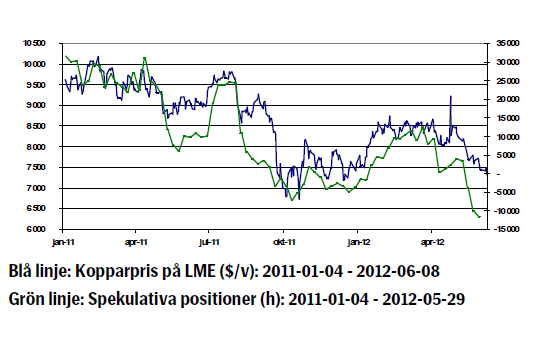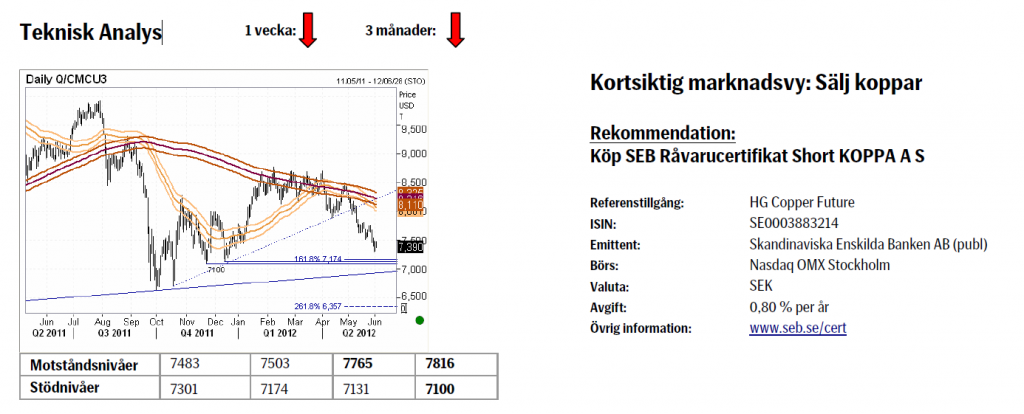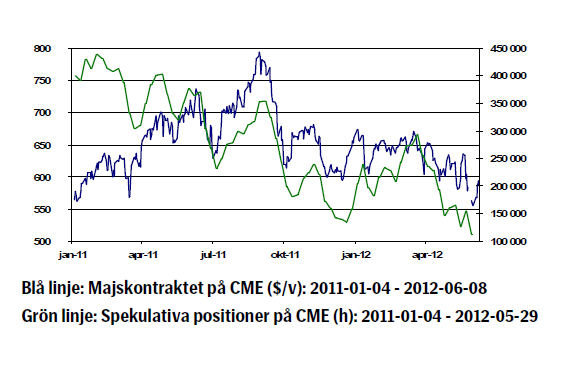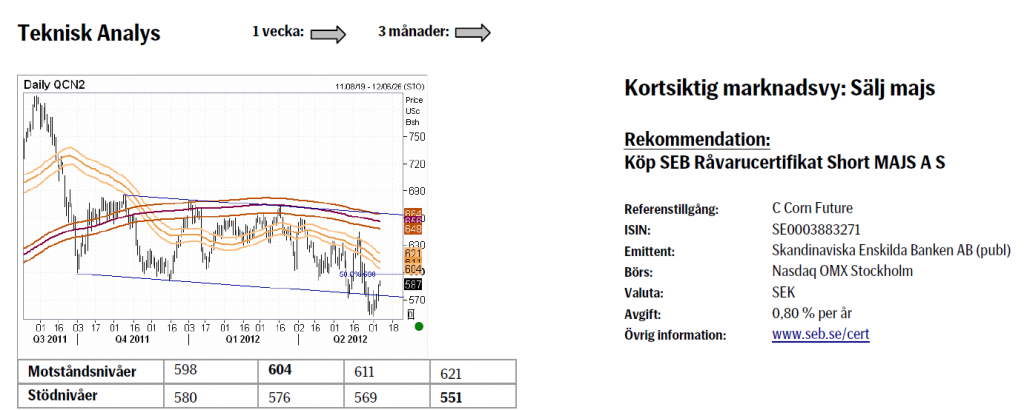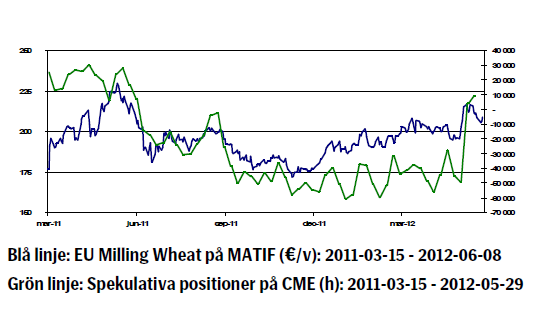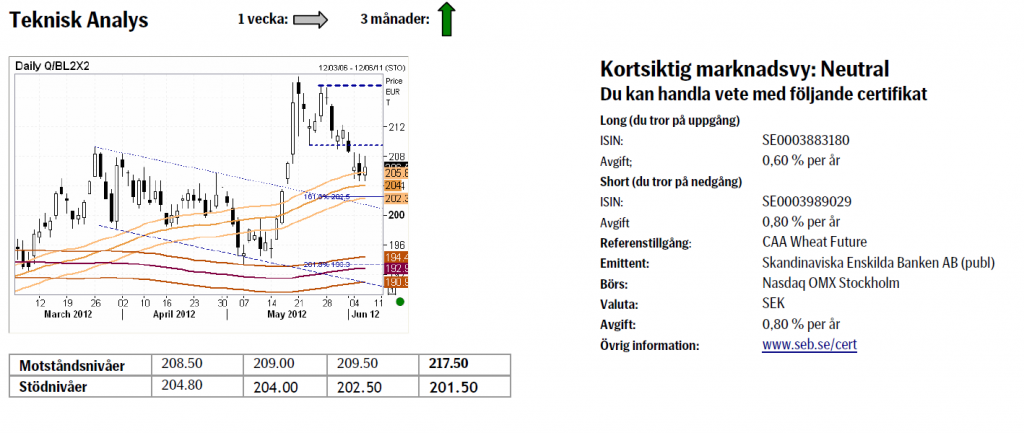Analys
SEB – Råvarukommentarer vecka 23 2012
Sammanfattning:
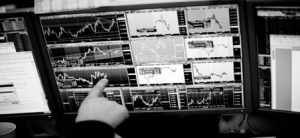 Brett råvaruindex: + 0,35 %
Brett råvaruindex: + 0,35 %
UBS Bloomberg CMCI TR Index- Energi: – 1,02 %
UBS Bloomberg CMCI Energy TR Index - Ädelmetaller: – 2,85%
UBS Bloomberg CMCI Precious Metals TR Index - Industrimetaller: – 0,47 %
UBS Bloomberg CMCI Industrial Metals TR Index - Jordbruk: +3,13 %
UBS Bloomberg CMCI Agriculture TR Index
Kortsiktig marknadsvy:
- Guld: Neutral
- Olja: Neutral/sälj
- Koppar: Sälj
- Majs: Sälj
- Vete: Neutral
Guld
Guldpriset steg som en reaktion på ökade QE3-förväntningar p.g.a. svaghet i den amerikanska arbetsmarknaden. Dollarn försvagades också efter fredagens dåliga jobbsiffror.
Igår, torsdag, talade Bernanke inför den amerikanska kongressen och marknaden lyssnade lyhört efter tecken på kvantitativa lättnader dvs. mera pengar i omlopp. Inget konkret kom ur mötet mer än att Fed står redo att stimulera om så krävs vilket fick guldet att falla tre procent.
En ökad penningmängd driver på guldpriset men även andra ”risky assets” såsom råvaror generellt och aktier. Idag faller guldet p.g.a. bristen på antydningar om kvantitativa lättnader och vi fortsätter ha en försiktig hållning till guldet efter den snabba rekylen efter förra veckans rally.
Oron kring den spanska ekonomin ökar. Landets tioårsränta har legat fem procent över den tyska motsvarigheten i nio dagar nu. Igår sålde spanska staten obligationer för två miljarder euro. Den 10-åriga stadsobligationen gav en ränta på 6,044 procent. Oron för Europa och Spanien ger stöd åt guldpriset.
Europeiska centralbanken lämnade på onsdagen styrräntan oförändrad på en procent. Draghis kommentarer efter beskedet tydde på att europeiska centralbanken önskar politiska initiativ för att möta de problem som eurozonen står inför.
Teknisk analys: I en kraftig uppgångsfas. Den större bilden har blivit ytterligare stärkt av den kraftiga uppgång som noterades i förra veckan. Viss respekt visas den över delen av 55- dagars bandet, men en rörelse ner mot 1609/1599 ska ses som korrektiv och ska köpas. En dagsstängning över bandet, nu vid 1634 och brott över en projektionsnivå vid 1648 skulle höja ribban för ett test också in i 233-dagars bandet som just nu börjar vid 1666.
Olja
Fallande råvarupriser inledde veckan efter fredagens svaga jobbsiffror från USA. Oljepriset, vilket fallit cirka tio procent den senaste veckan, drogs även ned av skuldoro i Europa och tecken på konjunkturavmattning i Kina.
Opec-länderna håller möte den 14 juni och på agendan kan förväntas en diskussion kring produktionsnivåer. Opec:s kvoter tillåter idag en produktion på 30 miljoner fat per dag men Opec:s medlemmar producerar runt 31,5 miljoner fat per dag. Saudiarabien som länge önskat ett oljepris på100 dollar har producerat mer än man gjort på decennier, detta i avsikt att få bättre effekt av sanktionerna mot Iran.
FN:s säkerhetsråd + Tyskland möter Iran igen den 18-19 juni och förhoppningarna är stora att man ska finna en lösning på den rådande konflikt som bottnar i misstankar om att Iran tillverkar anrikat uran i kärnvapensyfte.
American Petroleum Institute (API) redovisade på tisdagen att råoljelager sjönk ~1,2 miljoner fat förra veckan, vilket är fem procent högre jämfört med föregående år. Siffror från DOE visade att råoljelager sjönk marginellt samtidigt som lager för oljeprodukter steg.
Driving season i USA startade officiellt i samband med Memorial Day förra veckan och man kan nu förväntas se en ökning i efterfrågan av oljerelaterade produkter. Vi har svårt att se ett mycket högre oljepris på kort sikt man har man en något längre tidshorisont kan nuvarande nivåer vara intressanta att gå in på.
Teknisk analys: Korrektiv rörelse högre att vänta Även ett fritt fall tar någon gång slut. Den kortsiktigt överdrivna rörelsen ner mot $95.60 i måndags korrigeras nu och detta kan fortsätta upp mot första korrektionsmålet (23.6%) vid $102.70, möjligen också mot den fallande motståndslinjen, nu vid $103.50, eller t.o.m. mot gamla stödet vid $105.15. Tillbaka under $97.70 skulle omintetgöra möjligheterna till vidare uppgång i ett kortsiktigt perspektiv, utan i stället ställa om siktet mot höstens botten vid $94.35.
Koppar
London Metal Exchange (LME) var stängd måndag och tisdag p.g.a. helgdagar. Skuldoro i Europa och flera tecken på en konjunkturavmattning i Kina har länge lagt sordin på kopparpriset.
Kinesisk statistik har varit svag på sistone. Ökningen i industriproduktionen för april landade på drygt nio procent på årlig basis vilket är den sämsta siffran på tre år. Nyutlåningen till banker föll med 33 procent i april jämfört med mars i år. Mycket talar för att siffran blir ännu sämre för maj. Nyutlåningar är i nära kopplad till investeringar i fasta tillgångar som föll till ett 10-årslägsta i april.
För att möta inbromsningen sänkte igår kinesiska centralbanken räntan på ettåriga lån med 25 punkter, en sänkning som träder ikraft idag. Den ettåriga räntan ligger nu på 6,31 procent. Kopparpriset reagerade positivt på denna nyhet och steg med 1,20 procent på beskedet. Uppgången var kortvarit och hela uppgången från igår är idag borta. På kort sikt tror vi dock att vi kan se lägre priser.
Söndagen en 17:e juni går Grekland till val vilket handlar om huruvida det grekiska folket ska gå med på åtstramningar i utbyte mot nya krislån eller istället kräva att överenskommelsen med EU/IMF/ECB rivs upp. Det senare skulle med största sannolikhet leda till att Grekland tvingas lämna euron. Grekisk lag förbjuder publicering av opinionsmätningar två veckor före valdagen vilket ökar ovissheten.
HSBC:s index för tjänstesektorn steg till 54,7 i maj jämfört med 54,1 föregående månad och kinesiska företag är fortsatt optimistiska om framtidsutsikterna. Indexet är konstruerat så att värden över 50 innebär ekonomisk expansion. Index för tjänstesektorn står i skarp kontrast till motsvarande undersökningar för industrisektorn som visade att Kinas industri slog av på takten i maj. Kinas tjänstesektor står nu för hela 43 procent av ekonomin.
Teknisk analys: På väg mot $7174/7100. Den noterbara nedgången fortsätter med största sannolikhet ner mot nästa målområde som börjar med en projektionsnivå vid $7174, som sedan följs av botten som noterades i november förra året vid $7100 och därefter en mera långsiktig stigande stödlinje i $7000-området.
Majs
Majspriset Priset på decembermajs har varit stabilt pga. oro över det ovanligt torra vädret i USA samt obekräftade uppgifter om inköp av majs från Kina. En förväntad rekordproduktion i Brasilien och fortsatt goda skördar i USA fick dock priset att falla tillbaka i början av veckan.
Marknaden förväntade sig en försämring av kvalitén på majsskörden i USA men måndagens rapport från USDA uppvisade inga förändringar från föregående vecka utan good/excellent kvarstår på 72 procent vilket är väldigt högt.
USA:s majsskörd förväntas bli god och förväntas fylla på lager vars nivåer varit låga p.g.a. dåliga skördar föregående år.
Konsumtionen av majs till etanol har fallit p.g.a. att subventioner på inblandning i bensinen tagits bort från årsskiftet, vilket ytterligare tynger majspriset. På tisdag, den 12 juni, kommer USDA´s viktiga WASDE (World Agricultural Supply and Demand Estimates) rapport: Prognoserna för utbud och efterfrågan på majs förväntas höjas.
Trots torka så har prognosen för Brasiliens majsproduktion reviderats upp till rekordhöga 67,79 miljoner ton, jämfört med 65,9 miljoner ton för en månad sedan. Stämmer siffrorna så kommer det att vara första gången på över 10 år som Brasilien skördar mer majs än sojabönor. Goda skördar och gynnsamt väder gör att vi är fortsatt negativa till majspriset.
Teknisk analys: Återtest av tidigare stöd. Marknaden har klättrat tillbaka in i det tidigare stödområdet (som nyligen penetrerades). Vidare uppgång möter sannolikt motstånd närmare den lägre delen av det fallande 55-dagars bandet, nu vid 604.
Vete
Det europeiska Matifvetet med novemberleverans föll tillbaka i fredags och bröt igenom stödnivån på 210 EUR. Förbättrade väderutsikter i Europa och Svartahavsområdet tillsammans med svag makrostatistik drog ned priset på kvarnvetet som sedan dess har pendlat mellan stödnivån 205 EUR och 208 EUR.
Kontrasterna i Europa har varit stora veckan som gått med varmt torrt väder i de västra delarna och kallt och regnigt i öster. I Frankrike och England har den senaste tidens regn främjat höstgrödornas utveckling, men också gett upphov till ökad risk för sjukdomar. Även Tyskland, Polen och norra Balkan har fått välbehövligt regn (10-35 mm) medan det torra och varma vädret i Italien och Spanien har gynnat skörden av vete.
Måttliga regnskurar har förbättrat utsikterna i de veteproducerande områdena i södra Ukraina och i de södra delarna av Rysslands södra distrikt.
Prognosen för veteproduktionen inom EU-27 har reviderats ned med 200 000 ton till 126,5 miljoner ton, främst på grund av lägre förväntad avkastning i Tyskland, Bulgarien och Rumänien. Tyska lantbrukarna har återigen fått uppleva en torr vår, efter förra årets vår med extremt låg nederbörd. Tysklands spannmålsskörd förväntas i detta skede att hamna under landets genomsnittliga årliga produktion men rikliga regn under de kommande dagarna och veckorna kan fortfarande bidra till en positiv utveckling.
Crop condition för vintervetet i USA, som rapporterades i måndagskväll ligger nu på 52 procent good/excellent och det är TVÅ procent lägre än förra veckan. Nivån är emellertid bra och jämfört med förra året är den t.o.m. mycket bra. Skörden av vintervete i USA går betydligt fortare fram än vanligt. Utsikterna för veteskörden ser fortsatt bra ut och vi behåller vår neurala syn.
Teknisk analys: Utdragen korrektion Den pågående korrektionen lägre har tagit en djupare bana och kan möjligtvis bli mer komplicerad än vad som tidigare varit antaget. Stöd återfinns dock i 55-dagars bandet (€205.80/202.30), vid en projektionsnivå vid €202.50 och vid den tidigare brutna (fallande) motståndslinjen, nu vid €201.50. Under den senare skulle ifrågasätta om det bara är en korrektion eller om det är något större i görningen (då det skulle öppna också för ~€195). Tillbaka över €209.50 skulle minska trycket på nedsidan.
[box]SEB Veckobrev Veckans råvarukommentar är producerat av SEB Merchant Banking och publiceras i samarbete och med tillstånd på Råvarumarknaden.se[/box]
Disclaimer
The information in this document has been compiled by SEB Merchant Banking, a division within Skandinaviska Enskilda Banken AB (publ) (“SEB”).
Opinions contained in this report represent the bank’s present opinion only and are subject to change without notice. All information contained in this report has been compiled in good faith from sources believed to be reliable. However, no representation or warranty, expressed or implied, is made with respect to the completeness or accuracy of its contents and the information is not to be relied upon as authoritative. Anyone considering taking actions based upon the content of this document is urged to base his or her investment decisions upon such investigations as he or she deems necessary. This document is being provided as information only, and no specific actions are being solicited as a result of it; to the extent permitted by law, no liability whatsoever is accepted for any direct or consequential loss arising from use of this document or its contents.
About SEB
SEB is a public company incorporated in Stockholm, Sweden, with limited liability. It is a participant at major Nordic and other European Regulated Markets and Multilateral Trading Facilities (as well as some non-European equivalent markets) for trading in financial instruments, such as markets operated by NASDAQ OMX, NYSE Euronext, London Stock Exchange, Deutsche Börse, Swiss Exchanges, Turquoise and Chi-X. SEB is authorized and regulated by Finansinspektionen in Sweden; it is authorized and subject to limited regulation by the Financial Services Authority for the conduct of designated investment business in the UK, and is subject to the provisions of relevant regulators in all other jurisdictions where SEB conducts operations. SEB Merchant Banking. All rights reserved.
Analys
Brent crude ticks higher on tension, but market structure stays soft

Brent crude has climbed roughly USD 1.5-2 per barrel since Friday, yet falling USD 0.3 per barrel this mornig and currently trading near USD 67.25/bbl after yesterday’s climb. While the rally reflects short-term geopolitical tension, price action has been choppy, and crude remains locked in a broader range – caught between supply-side pressure and spot resilience.

Prices have been supported by renewed Ukrainian drone strikes targeting Russian infrastructure. Over the weekend, falling debris triggered a fire at the 20mtpa Kirishi refinery, following last week’s attack on the key Primorsk terminal.
Argus estimates that these attacks have halted ish 300 kbl/d of Russian refining capacity in August and September. While the market impact is limited for now, the action signals Kyiv’s growing willingness to disrupt oil flows – supporting a soft geopolitical floor under prices.
The political environment is shifting: the EU is reportedly considering sanctions on Indian and Chinese firms facilitating Russian crude flows, while the U.S. has so far held back – despite Bessent warning that any action from Washington depends on broader European participation. Senator Graham has also publicly criticized NATO members like Slovakia and Hungary for continuing Russian oil imports.
It’s worth noting that China and India remain the two largest buyers of Russian barrels since the invasion of Ukraine. While New Delhi has been hit with 50% secondary tariffs, Beijing has been spared so far.
Still, the broader supply/demand balance leans bearish. Futures markets reflect this: Brent’s prompt spread (gauge of near-term tightness) has narrowed to the current USD 0.42/bl, down from USD 0.96/bl two months ago, pointing to weakening backwardation.
This aligns with expectations for a record surplus in 2026, largely driven by the faster-than-anticipated return of OPEC+ barrels to market. OPEC+ is gathering in Vienna this week to begin revising member production capacity estimates – setting the stage for new output baselines from 2027. The group aims to agree on how to define “maximum sustainable capacity,” with a proposal expected by year-end.
While the IEA pegs OPEC+ capacity at 47.9 million barrels per day, actual output in August was only 42.4 million barrels per day. Disagreements over data and quota fairness (especially from Iraq and Nigeria) have already delayed this process. Angola even quit the group last year after being assigned a lower target than expected. It also remains unclear whether Russia and Iraq can regain earlier output levels due to infrastructure constraints.
Also, macro remains another key driver this week. A 25bp Fed rate cut is widely expected tomorrow (Wednesday), and commodities in general could benefit a potential cut.
Summing up: Brent crude continues to drift sideways, finding near-term support from geopolitics and refining strength. But with surplus building and market structure softening, the upside may remain capped.
Analys
Volatile but going nowhere. Brent crude circles USD 66 as market weighs surplus vs risk

Brent crude is essentially flat on the week, but after a volatile ride. Prices started Monday near USD 65.5/bl, climbed steadily to a mid-week high of USD 67.8/bl on Wednesday evening, before falling sharply – losing about USD 2/bl during Thursday’s session.

Brent is currently trading around USD 65.8/bl, right back where it began. The volatility reflects the market’s ongoing struggle to balance growing surplus risks against persistent geopolitical uncertainty and resilient refined product margins. Thursday’s slide snapped a three-day rally and came largely in response to a string of bearish signals, most notably from the IEA’s updated short-term outlook.
The IEA now projects record global oversupply in 2026, reinforcing concerns flagged earlier by the U.S. EIA, which already sees inventories building this quarter. The forecast comes just days after OPEC+ confirmed it will continue returning idle barrels to the market in October – albeit at a slower pace of +137,000 bl/d. While modest, the move underscores a steady push to reclaim market share and adds to supply-side pressure into year-end.
Thursday’s price drop also followed geopolitical incidences: Israeli airstrikes reportedly targeted Hamas leadership in Doha, while Russian drones crossed into Polish airspace – events that initially sent crude higher as traders covered short positions.
Yet, sentiment remains broadly cautious. Strong refining margins and low inventories at key pricing hubs like Europe continue to support the downside. Chinese stockpiling of discounted Russian barrels and tightness in refined product markets – especially diesel – are also lending support.
On the demand side, the IEA revised up its 2025 global demand growth forecast by 60,000 bl/d to 740,000 bl/d YoY, while leaving 2026 unchanged at 698,000 bl/d. Interestingly, the agency also signaled that its next long-term report could show global oil demand rising through 2050.
Meanwhile, OPEC offered a contrasting view in its latest Monthly Oil Market Report, maintaining expectations for a supply deficit both this year and next, even as its members raise output. The group kept its demand growth estimates for 2025 and 2026 unchanged at 1.29 million bl/d and 1.38 million bl/d, respectively.
We continue to watch whether the bearish supply outlook will outweigh geopolitical risk, and if Brent can continue to find support above USD 65/bl – a level increasingly seen as a soft floor for OPEC+ policy.
Analys
Waiting for the surplus while we worry about Israel and Qatar

Brent crude makes some gains as Israel’s attack on Hamas in Qatar rattles markets. Brent crude spiked to a high of USD 67.38/b yesterday as Israel made a strike on Hamas in Qatar. But it wasn’t able to hold on to that level and only closed up 0.6% in the end at USD 66.39/b. This morning it is starting on the up with a gain of 0.9% at USD 67/b. Still rattled by Israel’s attack on Hamas in Qatar yesterday. Brent is getting some help on the margin this morning with Asian equities higher and copper gaining half a percent. But the dark cloud of surplus ahead is nonetheless hanging over the market with Brent trading two dollar lower than last Tuesday.

Geopolitical risk premiums in oil rarely lasts long unless actual supply disruption kicks in. While Israel’s attack on Hamas in Qatar is shocking, the geopolitical risk lifting crude oil yesterday and this morning is unlikely to last very long as such geopolitical risk premiums usually do not last long unless real disruption kicks in.
US API data yesterday indicated a US crude and product stock build last week of 3.1 mb. The US API last evening released partial US oil inventory data indicating that US crude stocks rose 1.3 mb and middle distillates rose 1.5 mb while gasoline rose 0.3 mb. In total a bit more than 3 mb increase. US crude and product stocks usually rise around 1 mb per week this time of year. So US commercial crude and product stock rose 2 mb over the past week adjusted for the seasonal norm. Official and complete data are due today at 16:30.
A 2 mb/week seasonally adj. US stock build implies a 1 – 1.4 mb/d global surplus if it is persistent. Assume that if the global oil market is running a surplus then some 20% to 30% of that surplus ends up in US commercial inventories. A 2 mb seasonally adjusted inventory build equals 286 kb/d. Divide by 0.2 to 0.3 and we get an implied global surplus of 950 kb/d to 1430 kb/d. A 2 mb/week seasonally adjusted build in US oil inventories is close to noise unless it is a persistent pattern every week.
US IEA STEO oil report: Robust surplus ahead and Brent averaging USD 51/b in 2026. The US EIA yesterday released its monthly STEO oil report. It projected a large and persistent surplus ahead. It estimates a global surplus of 2.2 m/d from September to December this year. A 2.4 mb/d surplus in Q1-26 and an average surplus for 2026 of 1.6 mb/d resulting in an average Brent crude oil price of USD 51/b next year. And that includes an assumption where OPEC crude oil production only averages 27.8 mb/d in 2026 versus 27.0 mb/d in 2024 and 28.6 mb/d in August.
Brent will feel the bear-pressure once US/OECD stocks starts visible build. In the meanwhile the oil market sits waiting for this projected surplus to materialize in US and OECD inventories. Once they visibly starts to build on a consistent basis, then Brent crude will likely quickly lose altitude. And unless some unforeseen supply disruption kicks in, it is bound to happen.
US IEA STEO September report. In total not much different than it was in January

US IEA STEO September report. US crude oil production contracting in 2026, but NGLs still growing. Close to zero net liquids growth in total.

-

 Nyheter4 veckor sedan
Nyheter4 veckor sedanMeta bygger ett AI-datacenter på 5 GW och 2,25 GW gaskraftverk
-

 Nyheter4 veckor sedan
Nyheter4 veckor sedanAker BP gör ett av Norges största oljefynd på ett decennium, stärker resurserna i Yggdrasilområdet
-

 Nyheter4 veckor sedan
Nyheter4 veckor sedanSommarens torka kan ge högre elpriser i höst
-

 Analys4 veckor sedan
Analys4 veckor sedanBrent edges higher as India–Russia oil trade draws U.S. ire and Powell takes the stage at Jackson Hole
-

 Nyheter3 veckor sedan
Nyheter3 veckor sedanMahvie Minerals är verksamt i guldrikt område i Finland
-

 Analys3 veckor sedan
Analys3 veckor sedanIncreasing risk that OPEC+ will unwind the last 1.65 mb/d of cuts when they meet on 7 September
-

 Nyheter3 veckor sedan
Nyheter3 veckor sedanNeil Atkinson spår att priset på olja kommer att stiga till 70 USD
-

 Analys2 veckor sedan
Analys2 veckor sedanOPEC+ in a process of retaking market share


